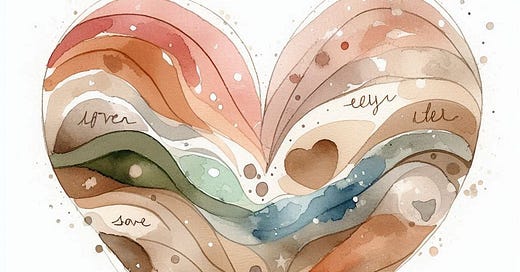I’m not just writing about love languages today because it’s Valentine’s Day. I’m writing about them because your love language plays an important role in healing. From a holistic perspective, every aspect of your life is a opportunity to heal- from your romantic relationships to your relationship with your doctor, your body, your inner child and the natural environment. If you know what you need to feel loved and cared for in this world, healing becomes a whole lot easier.
You may already be familiar with the 5 love languages popularized by the best selling author and counselor, Gary Chapman. He suggests that there are five distinct ways in which we give and receive love. His work empowers couples to explore their preferred love languages as a means to greater satisfaction and longevity in their relationship.
I respect Chapman’s work, but I find his five languages (words of affirmation, acts of service, receiving gifts, quality time and physical touch) to be limiting and inappropriately relationship-centric.
When our love languages can only be communicated in the context of relationship with another person, the healing power of love is limited, as is the holistic nature of the self.
There is a difference between love and romance. Love is a matter of the heart chakra, whereas romance surfs the dramatic waters of the sacral chakra. Chapman’s five languages confine love to the lower chakras, and if you read my chakra series, you already know how limiting that is.
According to Chapman’s work, if your love language is words of affirmation or physical touch, and your Mother has already passed, it’s impossible for you to receive your Mother’s love. In my experience, if we’re healing the root cause of dis-ease, receiving love from the unseen, metaphysical realms is not only possible, but it’s essential.
Chapman’s orientation to love is far from holistic. It’s rooted (and stuck) in the sacral chakra, where the highs are high and the lows are low- but love in is purist form radiates from the heart chakra, where humanity becomes the bridge between heaven and earth.
Love is not simply something that’s exchanged between 2 people. Love is the exhale of the divine, breathing life into all of existence. It’s nourishment from the earth sustaining life. It’s the abundant flow of water supporting and protecting life. It’s the warmth of the sun’s rays filling life with delight. It’s the inhale of the great mystery, calling all of life back into her limitless embrace.
Love fuels the eternal symphony of existence. It’s not here to ensure that we stay married until death due us part. It’s here to create the miracle that we are. Love is here to provide a sensory playground that fills us with delight for our whole lives. It’s here so that our minds have something pure to serve. It’s here to connect us to each other and to the whole- even when we’re in pain … especially when we’re in pain. Love is here to provide the music so our souls never stop dancing. It’s is here to ensure that we honor our ancestors while staying devoted to our children. Love is here so that we never forget the exquisite masterpiece that we are all a part of.
All that is well-loved, grows. When we are loved, we heal. But in order to be loved, we have to be able to recognize love in all its expressions and let it in. This is why love languages play such an important role in healing. But if our collective understanding of love languages is confined to Chapman’s five, our healing is limited.
So let’s redefine the love languages in a way that honors the truth of what love is! Let’s find expressions of love that acknowledge the fullness of who we are and what we’re capable of! And let’s use the love languages to support our healing- not just in couple’s therapy but holistically!
In the next section, I’ll present a new set of love languages and discuss the role each one plays in your healing.
Happy Valentine’s Day friends!
Keep reading with a 7-day free trial
Subscribe to Becoming Whole x Dr. Erica Matluck to keep reading this post and get 7 days of free access to the full post archives.






